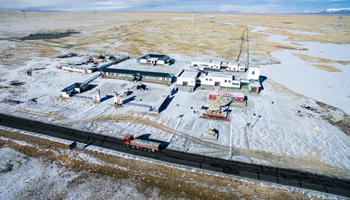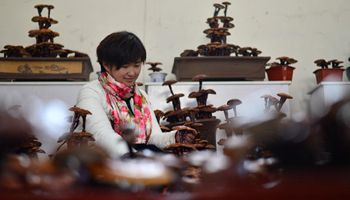HOHHOT, Dec. 2 (Xinhua) -- Yang Shuqi, 58, on his motorcycle, is patrolling the bushwood he manages in the Tengger Desert in northern China's Inner Mongolia Autonomous Region.
Yang spends half of every month caring for the 300,000 mu (20,000 hectares) of bushwood in the 40,000-square-kilometer desert.
"When I was young, sand dunes surrounded our houses, and the sheep pen would be buried with sand after a night's storm," said Yang. "With more trees and less storms now, our life is better."
Yang lives in Alxa Left Banner in Alxa League Prefecture, which has three deserts. The deserts, including Tengger Desert, which extends into neighboring Ningxia Hui Autonomous Region and Gansu Province, stretch for 90,000 square kilometers in total, almost the area of Hungary.
Before the 1990s, dry climate and over-grazing led to serious desertification, affecting water sources, grasslands and their lives.
"There was not much grass for sheep, which drove down our wool production and the price of lamb. We couldn't make ends meet," Wang Cuiying, Yang's wife, said.
In 1992, the local forestry department began an aerial seeding project to reforest the county.
"Aerial seeding was carried out on 60,000 mu of land, and over 60 percent survived." said Liu Hongyi, head of the county's forestry bureau.
Yang and his wife were among the 20 families who benefited from the afforestation drive that year.
"The government has not only helped us plant trees to improve the environment, but they are concerned about our income as well," said Yang.
According to Yang, each farmer who gives up herding so that their land can be planted with trees receives 13,000 yuan each year (about 1,800 U.S. dollars) from the government.
The compensation system, which is covered by the central government, officially began in 2004 following three years of trials. Over 100 billion yuan has been poured into the management and protection of the forests over the past ten years, with 16.5 billion yuan this year alone.
The farmers also make money from harvesting seeds from the trees, which are sold to the government for other aerial seeding projects.
"Every family can earn over 10,000 yuan annually, more than they earned from herding sheep," said Yang.
The county's herdsmen have provided around 30 tonnes of seeds for the forestry department each year since 2004. Thanks, in part, to their efforts, 790,000 mu of trees have been planted in the county over the past two decades.
Farmers also choose to plant drought-enduring economic trees, such as sacsaoul, generating more income.
Sacsaoul, a bush that anchors into sand with its roots, is often grafted with herbs such as cistanche and cynomorium, which are both used in traditional Chinese medicine.
According to Liu, in 2011 Alxa Left Banner set the ambitious goal of growing 400,000 mu of sacsaoul trees. To date, 350,000 mu has been planted. Farmers are also granted 60 yuan per mu if they grow a particular type of tree.
Among the trees, 26,000 mu have been grafted with the herb cistanche, which farmers will be able to harvest and sell next year.
According to forestry department statistics, a 350 km sand belt has been built to stop sand from invading the nearby counties.
"Several projects have been carried out in Alxa League since 2000, including the building of forest shelters, the return of grazing land to grassland, and the planting of non-commercial forests to protect the environment ecology, not to mention the compensation system," said Qiao Yongxiang, deputy director of forestry bureau of Alxa.
"The income of farmers has increased thanks to our sand control and afforestation efforts," said Liu.










